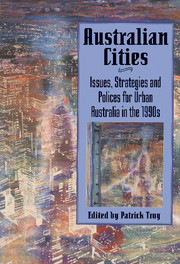Book contents
- Frontmatter
- Contents
- List of Figures
- List of Tables
- Preface
- Acknowledgements
- Note on Contributors
- Abbreviations
- Introduction
- Part I The Development and State of Australian Cities
- 1 Sustaining Suburbia: An Historical Perspective on Australia's Growth
- 2 The Urban Debate: From ‘Los Angeles’ to the Urban Village
- 3 National Urban Policy in the 1990s
- 4 Households, Consumerism, and Metropolitan Development
- Part II Current Policies and Options
- Part III Avenues for Development
- References
- Index
1 - Sustaining Suburbia: An Historical Perspective on Australia's Growth
Published online by Cambridge University Press: 03 May 2011
- Frontmatter
- Contents
- List of Figures
- List of Tables
- Preface
- Acknowledgements
- Note on Contributors
- Abbreviations
- Introduction
- Part I The Development and State of Australian Cities
- 1 Sustaining Suburbia: An Historical Perspective on Australia's Growth
- 2 The Urban Debate: From ‘Los Angeles’ to the Urban Village
- 3 National Urban Policy in the 1990s
- 4 Households, Consumerism, and Metropolitan Development
- Part II Current Policies and Options
- Part III Avenues for Development
- References
- Index
Summary
Few people who each day battle traffic jams, suffer from pollution, or face shortages of services in far-flung suburbs appreciate how much the modern urban landscape is a creation of the past. At the start of the twentieth century Australia's major cities had either already developed a low-density townscape with significant decentralisation of housing and jobs, or were beginning to sprawl at the edge of their old, compact core. This low-density physical form was built in an attempt to avoid the sort of urban problems which can develop in a high-density setting. As city populations grew, heavy investment in public transport and infrastructure was needed if this land-extensive housing stock was to be replicated and improved. During the twentieth century, improvements in public transport encouraged commuting and the creation of new suburbs, but the system eventually became congested. Jobs came to be increasingly located away from the old downtown and commuters began to switch to private transport. Road building enabled cities to sprawl further and eventually outrun their public transport systems. The costs mounted up over time as the provision of infrastructure lagged behind population growth and the dependence of new, distant suburbs on cars saw an increase in the volume of traffic and associated disamenities.
- Type
- Chapter
- Information
- Australian CitiesIssues, Strategies and Policies for Urban Australia in the 1990s, pp. 20 - 38Publisher: Cambridge University PressPrint publication year: 1995
- 16
- Cited by



